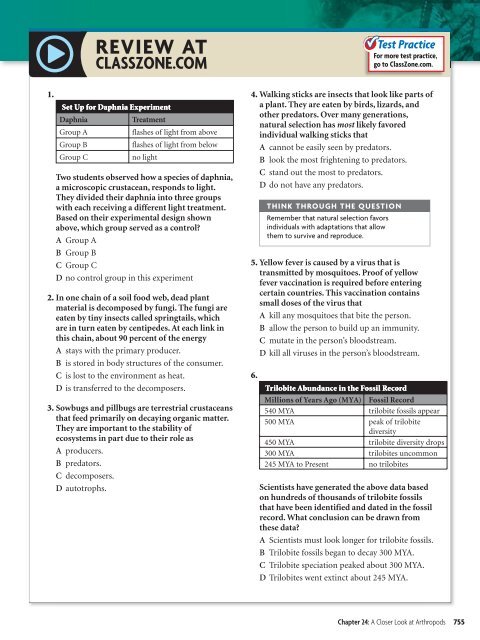24 A Closer Look at Arthropods
24 A Closer Look at Arthropods
24 A Closer Look at Arthropods
Create successful ePaper yourself
Turn your PDF publications into a flip-book with our unique Google optimized e-Paper software.
For more test practice,<br />
go to ClassZone.com.<br />
1.<br />
Set Up for Daphnia Experiment<br />
Daphnia<br />
Tre<strong>at</strong>ment<br />
Group A<br />
flashes of light from above<br />
Group B<br />
flashes of light from below<br />
Group C<br />
no light<br />
Two students observed how a species of daphnia,<br />
a microscopic crustacean, responds to light.<br />
They divided their daphnia into three groups<br />
with each receiving a different light tre<strong>at</strong>ment.<br />
Based on their experimental design shown<br />
above, which group served as a control?<br />
A Group A<br />
B Group B<br />
C Group C<br />
D no control group in this experiment<br />
2. In one chain of a soil food web, dead plant<br />
m<strong>at</strong>erial is decomposed by fungi. The fungi are<br />
e<strong>at</strong>en by tiny insects called springtails, which<br />
are in turn e<strong>at</strong>en by centipedes. At each link in<br />
this chain, about 90 percent of the energy<br />
A stays with the primary producer.<br />
B is stored in body structures of the consumer.<br />
C is lost to the environment as he<strong>at</strong>.<br />
D is transferred to the decomposers.<br />
3. Sowbugs and pillbugs are terrestrial crustaceans<br />
th<strong>at</strong> feed primarily on decaying organic m<strong>at</strong>ter.<br />
They are important to the stability of<br />
ecosystems in part due to their role as<br />
A producers.<br />
B pred<strong>at</strong>ors.<br />
C decomposers.<br />
D autotrophs.<br />
4. Walking sticks are insects th<strong>at</strong> look like parts of<br />
a plant. They are e<strong>at</strong>en by birds, lizards, and<br />
other pred<strong>at</strong>ors. Over many gener<strong>at</strong>ions,<br />
n<strong>at</strong>ural selection has most likely favored<br />
individual walking sticks th<strong>at</strong><br />
A cannot be easily seen by pred<strong>at</strong>ors.<br />
B look the most frightening to pred<strong>at</strong>ors.<br />
C stand out the most to pred<strong>at</strong>ors.<br />
D do not have any pred<strong>at</strong>ors.<br />
THINK THROUGH THE QUESTION<br />
Remember th<strong>at</strong> n<strong>at</strong>ural selection favors<br />
individuals with adapt<strong>at</strong>ions th<strong>at</strong> allow<br />
them to survive and reproduce.<br />
5. Yellow fever is caused by a virus th<strong>at</strong> is<br />
transmitted by mosquitoes. Proof of yellow<br />
fever vaccin<strong>at</strong>ion is required before entering<br />
certain countries. This vaccin<strong>at</strong>ion contains<br />
small doses of the virus th<strong>at</strong><br />
A kill any mosquitoes th<strong>at</strong> bite the person.<br />
B allow the person to build up an immunity.<br />
C mut<strong>at</strong>e in the person’s bloodstream.<br />
D kill all viruses in the person’s bloodstream.<br />
6.<br />
Trilobite Abundance in the Fossil Record<br />
Millions of Years Ago (MYA) Fossil Record<br />
540 MYA trilobite fossils appear<br />
500 MYA peak of trilobite<br />
diversity<br />
450 MYA trilobite diversity drops<br />
300 MYA trilobites uncommon<br />
<strong>24</strong>5 MYA to Present no trilobites<br />
Scientists have gener<strong>at</strong>ed the above d<strong>at</strong>a based<br />
on hundreds of thousands of trilobite fossils<br />
th<strong>at</strong> have been identified and d<strong>at</strong>ed in the fossil<br />
record. Wh<strong>at</strong> conclusion can be drawn from<br />
these d<strong>at</strong>a?<br />
A Scientists must look longer for trilobite fossils.<br />
B Trilobite fossils began to decay 300 MYA.<br />
C Trilobite speci<strong>at</strong>ion peaked about 300 MYA.<br />
D Trilobites went extinct about <strong>24</strong>5 MYA.<br />
Chapter <strong>24</strong>: A <strong>Closer</strong> <strong>Look</strong> <strong>at</strong> <strong>Arthropods</strong> 755

















